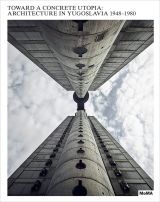Toward a Concrete Utopia: Architecture in Yugoslavia, 1948–1980

ituated between the two rival Cold War blocs, Yugoslavia produced a “parallel universe” of modern architecture, built to meet the needs of the country’s unique brand of self-managing socialism, often described as the “Third Way.” Responding to the social and political climate, Yugoslav architects freely reinterpreted international currents in design, merging them with a variety of local building traditions. At the same time, Yugoslavia also became a major exporter of modernist architecture to postcolonial Africa and the Middle East. While the remarkable body of work that emerged in the postwar socialist era has sparked recurrent international interest, no rigorous examination of this understudied but significant chapter in the history of architectural modernism has been available in the United States until now.
Published in conjunction with a major exhibition at The Museum of Modern Art on the architectural production of Yugoslavia between 1948 and 1980, this groundbreaking, richly illustrated volume, features new scholarship, unpublished archival materials, and a portfolio of contemporary photographs by Valentin Jeck. Shedding light on key concepts of Yugoslav architecture, urbanism, and society by delving into the exceptional projects and key figures of the era, the publication provides a broader understanding of postwar modernism on a global scale.
Edited by Martino Stierli and Vladimir Kulić, with essays by Tamara Bjažić Klarin, Vladimir Deskov, Andrew Herscher, Sanja Horvatinčić, Theodossis Issaias, Ana Ivanovska Deskova, Jovan Ivanovski, Jelica Jovanović, Anna Kats, Juliet Kinchin, Martina Malešič, Maroje Mrduljaš, Arber Sadiki, Luka Skansi, Łukasz Stanek, Matthew Worsnick, Mejrema Zatrić. Photographic portfolio by Valentin Jeck.
Ukázky z knihy (pro zvětšení klikněte)    
Diskuze
Žádný příspěvek do diskuze. Přidejte svůj názor »
|













